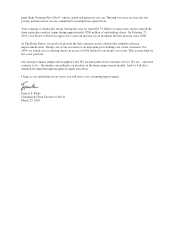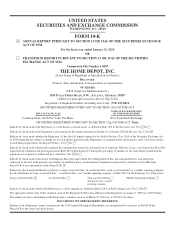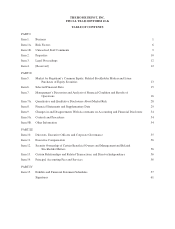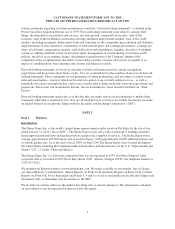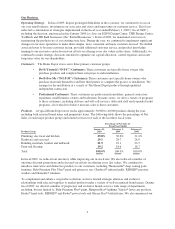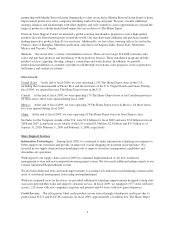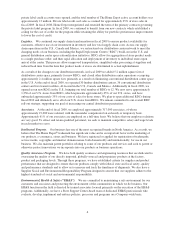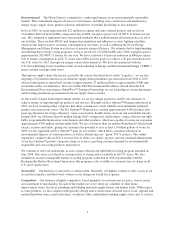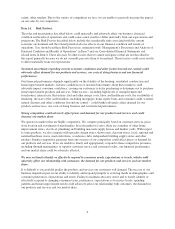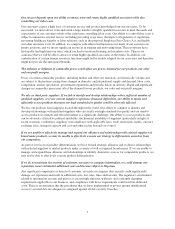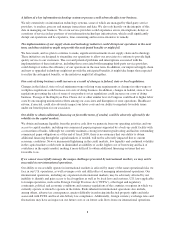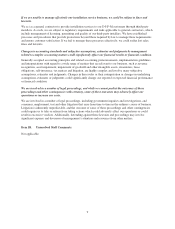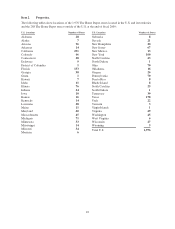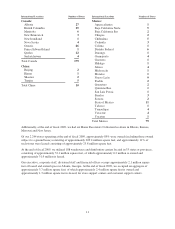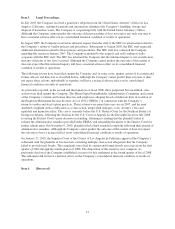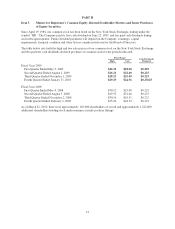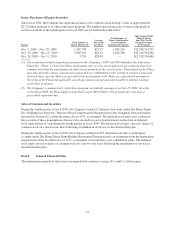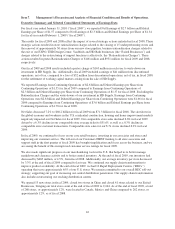Home Depot 2009 Annual Report Download - page 14
Download and view the complete annual report
Please find page 14 of the 2009 Home Depot annual report below. You can navigate through the pages in the report by either clicking on the pages listed below, or by using the keyword search tool below to find specific information within the annual report.A failure of a key information technology system or process could adversely affect our business.
We rely extensively on information technology systems, some of which are managed by third-party service
providers, to analyze, process and manage transactions and data. We also rely heavily on the integrity of this
data in managing our business. We or our service providers could experience errors, interruptions, delays or
cessations of service in key portions of our information technology infrastructure, which could significantly
disrupt our operations and be expensive, time consuming and resource-intensive to remedy.
The implementation of our supply chain and technology initiatives could disrupt our operations in the near
term, and these initiatives might not provide the anticipated benefits or might fail.
We have made, and we plan to continue to make, significant investments in our supply chain and technology.
These initiatives are designed to streamline our operations to allow our associates to continue to provide high
quality service to our customers. The cost and potential problems and interruptions associated with the
implementation of these initiatives, including those associated with managing third-party service providers,
could disrupt or reduce the efficiency of our operations in the near term. In addition, our improved supply chain
and new or upgraded technology might not provide the anticipated benefits, it might take longer than expected
to realize the anticipated benefits, or the initiatives might fail altogether.
Our costs of doing business could increase as a result of changes in federal, state or local regulations.
Changes in the federal, state or local minimum wage or living wage requirements or changes in other wage or
workplace regulations could increase our costs of doing business. In addition, changes in federal, state or local
regulations governing the sale of some of our products or tax regulations could increase our costs of doing
business. Passage of the Employee Free Choice Act or other similar laws in Congress could lead to higher labor
costs by encouraging unionization efforts among our associates and disruption of store operations. Healthcare
reform, if enacted, could also adversely impact our labor costs and our ability to negotiate favorable terms
under our benefit plans for our associates.
Our ability to obtain additional financing on favorable terms, if needed, could be adversely affected by the
volatility in the capital markets.
We obtain and manage liquidity from the positive cash flow we generate from our operating activities and our
access to capital markets, including our commercial paper programs supported by a back-up credit facility with
a consortium of banks. Although we currently maintain a strong investment grade rating and had no outstanding
commercial paper obligations as of the end of fiscal 2009, there is no assurance that our ability to obtain
additional financing through the capital markets, if needed, will not be adversely impacted due to current
economic conditions. New or incremental tightening in the credit markets, low liquidity and continued volatility
in the capital markets could result in diminished availability of credit, higher cost of borrowing and lack of
confidence in the equity market, making it more difficult to obtain additional financing on terms that are
favorable to us.
If we cannot successfully manage the unique challenges presented by international markets, we may not be
successful in our international operations.
Our ability to successfully operate in international markets is affected by many of the same operational risks we
face in our U.S. operations, as well as unique costs and difficulties of managing international operations. Our
international operations, including any expansion in international markets, may be adversely affected by our
inability to identify and gain access to local suppliers as well as by local laws and customs, U.S. laws applicable
to foreign operations, such as the Foreign Corrupt Practices Act (“FCPA”), other legal and regulatory
constraints, political and economic conditions and currency regulations of the countries or regions in which we
currently operate or intend to operate in the future. Risks inherent in international operations also include,
among others, adverse tax consequences, greater difficulty in enforcing intellectual property rights and risks
associated with FCPA and local anti-bribery law compliance. Additionally, foreign currency exchange rates and
fluctuations may have an impact on our future costs or on future cash flows from our international operations.
8


